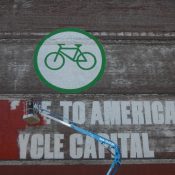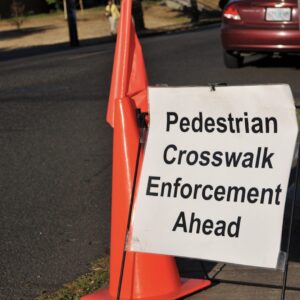
A member of the Portland Bureau of Transportation Pedestrian Advisory Committee (PAC) has decided to resign from the committee for what she says is the agency’s, “inability to respond swiftly and proactively to the crises we are facing, the lack of creative thinking and solutions, and reasons why we need to see more action from the agency.”
Evelyn Amara Ferreira, a walking and sustainability advocate who’s also CEO and founder Earthen Exchange, has served three years of her four-year term on the PAC. In a letter sent Tuesday to other members of the committee (read it below), Amara Ferreira said, “This wasn’t an easy decision to make, but I’m finding it difficult to be an active participant on the committee and bring my full and generally optimistic self to the table.”
The move comes one week after members of the PBOT Bicycle Advisory Committee excoriated the agency for its handling of a recent project where BAC members did not feel respectfully engaged in the decision-making process.
“What I see right now is a lot of people being really burned out… because they just get tired of hitting these brick walls,” BAC member Clint Culpepper said last week. And member Iain Mackenzie added, “I think we really need to have a conversation with PBOT about how to engage with this committee because they don’t take it seriously. They don’t.”
Advertisement
“Walkability and public space are essential to democracy and community building… Pedestrian-centered infrastructure has not kept to pace.”
— Evelyn Amara Ferreira
For her part, Amara Ferreira says she’s dismayed by PBOT’s slow rate of progress when it comes to creating a more walkable city. “Pedestrian-centered infrastructure has not kept to pace with increases to the number of Portland drivers, vehicles on the road, public safety concerns, cultural shifts, environmental emergencies, and public health crises,” she wrote in her announcement.
Last year Portland’s traffic death toll reached a 24-year high and the proportion of people who were killed while walking has increased. In the past three years, the number of walking deaths has accounted for more than one-third of the total fatalities.
Amara Ferreira added that when she joined the PAC she wanted to have some influence over projects that would “center pedestrians” and “have a noticeable impact on Portland’s walkability and pedestrian experience.”
“Walkability and public space are essential to democracy and community building,” she said about the dire need for more carfree spaces and public plazas in Portland. “Public places have traditionally served as places where anyone, regardless of income or position, can meet, discuss, demonstrate and publicise their causes. The extent to which these spaces are disappearing and the effect on civic life deserves more attention, particularly as part of PBOT’s commitment to equity and social justice.”
One specific policy that seems to have been the last straw for Amara Ferreira was a recent decision by PBOT to reduce the width of crosswalk striping installations to save money. In her letter she says the decision to reduce the width of new crosswalk stripes by 25% to save money was done with a “lack of conversation” with the PAC. “This raises questions regarding our role as the PAC.”
I’ve asked for clarification about this crosswalk policy from both Amara Ferreira and PBOT and will update this post when I hear back (see updated below).
You can read her full letter below:
[pdf-embedder url=”https://bikeportland.org/wp-content/uploads/2021/02/Evelyns-PAC-Announcement-For-February-16-2021.pdf” title=”Evelyn’s PAC Announcement (For February 16, 2021)”]
UPDATE, 2:20 pm: Here’s what PBOT says about the crosswalk policy Amara Ferreira referenced in her letter:
We have adopted the ladder bar crosswalk, also referred to as the continental crosswalk, as the new standard crosswalk design in Portland. This replaces the old parallel line design. We’ve made this change because there is a robust body of research that shows that continental crosswalks are much more visible and in this way contribute to a safer transportation system.
We have three standard crosswalk widths in Portland: 10′, 12′ and 15′. The material we use to install the crosswalks comes in 3′ lengths. Practically this has meant that those crosswalks that were 10′ wide are now, or will be, 9′ wide. The other crosswalks, their widths divisible by three, have not been affected.
Some pedestrian advocates have expressed concern regarding the loss of the one foot on the 10′ crosswalks. In response to this, we are exploring the possibility of simply converting those 10′ crosswalks to 12′ crosswalks.
It should also be noted that continental crosswalks use more materials and thus cost more to install. In other words, by adopting this new design we have actually increased our investment in crosswalks.
— Jonathan Maus: (503) 706-8804, @jonathan_maus on Twitter and jonathan@bikeportland.org
— Get our headlines delivered to your inbox.
— Support this independent community media outlet with a one-time contribution or monthly subscription.





Thanks for reading.
BikePortland has served this community with independent community journalism since 2005. We rely on subscriptions from readers like you to survive. Your financial support is vital in keeping this valuable resource alive and well.
Please subscribe today to strengthen and expand our work.
I’m not addressing specifics here regarding Ferreira, but as a Portlander it is frustrating as hell that we (Portland, Oregon, the US) haven’t taken this last year to make big leaps forward. I feel like big ideas are hard to implement because one of the impediments to implementation is that it’s going to be disruptive to the system. We’ve got the biggest system disruption possible going right now. Let’s make the most of it. Traffic is waaaay down. Make meaningful changes and as people slowly get back into commuting out there everyday it’s a gradual reintroduction to the changes. I’m thinking specifically about bike infrastructure here. But it seems to me, and to be clear, I’m a bonehead, that now is the time to move. Coal industry has taken a shit? Hard transition to renewables. Portland needs better bike infrastructure? Do it now! Want to remove parking and be able to use that space smarter in the future? Great! You’re never gonna get a better chance than this moment! Now isn’t the time to be timid. Etc. Etc.
I’m at work and can’t be more concise about my thoughts there, and again, I’m a bonehead, but I hope what I’m trying to say is coming across well enough.
Waiting passively for your public agencies to “do the right thing” is the most ineffective advocacy method I know, and yet it’s far and away the most common method, both in low-status communities like where I live here in NC, and in progressive Portland. When I advocated for projects in East Portland 2009-15, part of my success was based on working and learning from other aggressive community transportation advocates from across the city (we met monthly at coffee shops), but it was also partly because most of the BAC and PAC members were so passive and ineffective as advocates that it was relatively easy to influence the engineering decision-makers at PBOT.
I don’t know who, but someone needs to offer a series of aggressive advocacy teach-ins and regular support groups to train PAC and BAC appointees to be a hell of a lot more proactive than they tend to be. Obviously PBOT can’t be teaching it, it would only help them to weed out people like me (and they did try very hard to get rid of me).
That’s an excellent suggestion, David. I hope someone will run with it (maybe the good folks at BikeLoud already are).
I fully support members of the PAC and BAC who wish to leave. Their voices have been ignored consistently. We see a decade of modal share decline and historic road fatalities. PBoT and the city council have continued to design roads for car capacity and parking often precluding research-based safety measures. The inevitable outcome continues this year with 13 deaths to date.
Advisory Committees only exist to placate activist and make sure they aren’t engaged in activity that will actually change things. If you didn’t buy your seat on an AC, you are not going to be listened to.
Yep – that’s my experience also. The ACs allow public agencies to check the “public outreach” box as they proceed to do what they intended to do all along.
The PBOT response is pretty disheartening. The member resigns over the slow rate of change and not being consulted on a change that impactcs pedestrian afety. PBOT’s response ignores the slow rate of change and ignoring the PAC, and just focuses on the details of the the thermoplasitc. PBOT CLEARLY DOES NOT GET IT. There are so many examples of recent projects with potential to improve biking/walking safety that are just tanked by PBOT. I am thinking of hawthorne,Greeley, 7th greenway, even Flanders (it looks like we have a bridge to nowhere- where is the greenway?!). PBOT is so pathetic right now.
The most common parallel bar crosswalk was 12′ overall, and 10′ inside the parallel lines. The 12′ overall gave more protection from stopped cars, and more room to keep away from adjacent moving traffic. Restriping them as 9′ Continental crosswalks reduced the space set aside for pedestrians by 25%. Calling them 10′ discounts the effect of the side lines, and makes 9’sound like less of a change.
True dat, Doug. When I read the PBOT comment: “Geez – I guess we could just make the nine-foot crosswalks into twelve-foot crosswalks,” I thought: WTF, PBOT! Isn’t that what any thinking person would do? It’s like they went out of their way to troll pedestrians and ped advocates.
Every profession I know takes a “Do no harm” approach to change, but not PBOT, apparently.
After reading Amara’s letter, my overall reaction is:
PBOT doesn’t deserve her – her intelligence, her professionalism, her insight. Unfortunately she is like so many of us who have been abused by the public-involvement processes in Portland.
This is where PBOT and ODOT overlap significantly. They both clumsily and disingenuously use the public engagement process to support predetermined goals that are driven by bureaucratic inertia. The main difference appears to be PBOT not knowing how vs. ODOT’s full-on Machiavellian instincts.
When I lived in San Francisco and Seattle after growing up in Milwaukie I realized that driving in those cities, unlike Portland, was a privilege; you got the feeling that it was the pedestrian’s space you were driving through. And so it was slow going in a car, with parking extremely difficult. Even if, like Seattle a whole lotta people drive.
In Portland we think: while we just knock it outta the park when it comes to being the best little city this side of Reno on transportation, PRACTICALLY, driving is simply how working people who need to get things done get around. And so pedestrian/bike infrastructure is window-dressing
As Ms. Ferreira seems to support, newcomers seem fully on board with the “all driving all the time” ethos and we’ve seen modal share numbers that are embarassing–embarassing people! “Progressive Portlandia” and 70% drive alone!–what a joke.
Thankfully, now I see way more people walking, (sadly not more people biking) –organic change likely due to the increased areas of density. That may be partly why there’s more pedestrians dying.
Naturally then you’d expect our public officials to build to support the walkers. But PBOT and silly, stupid, death-inducing ODOT are pathologically stuck in the past. I mean even compare rural highways in Oregon to Washington. When its raining on those curvey, two lane roads between say Bend and Eugene or Bend and Salem which are all experiencing huge growth, and you have 9 pick-ups backed up behind you trying to make you drive 80, you are taking your life into your hands. In Washington highways are way safer.
PBOt’s response “well, we made some decoration changes…so there!”.
Sure. How about them one ways?